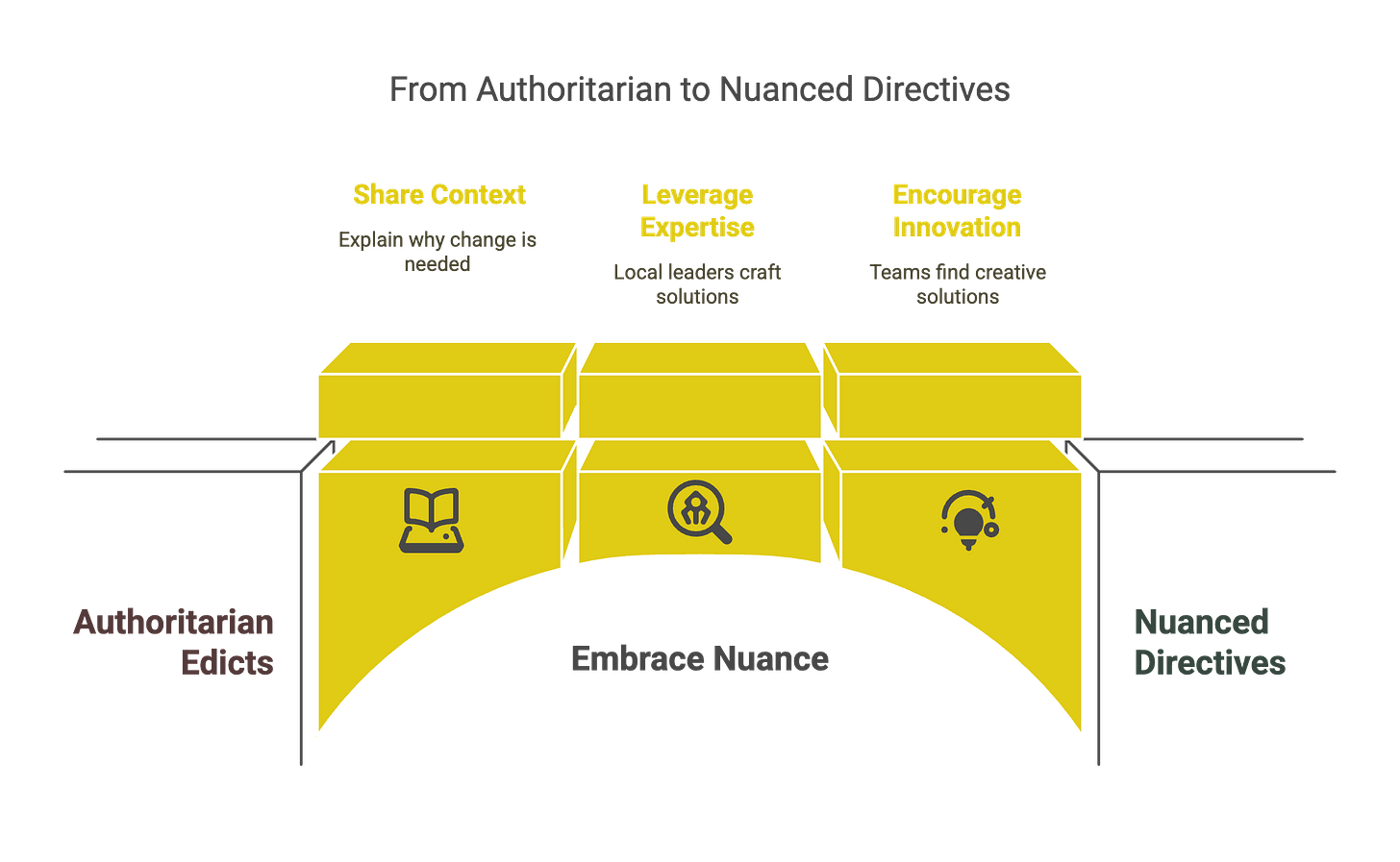Edicts - The Unstoppable Force
Authoritarian vs Nuanced Edicts
Authoritarian Edicts: The Unstoppable Force (No Matter the Collateral Damage)
Authoritarian edicts are non-negotiable and absolute. They barrel through the organization like a freight train, flattening context, data, and dissent in their path. Even as a senior leader, you can’t tweak, debate, or, most importantly, align them with the real-world nuances of your part of the business.
Personal Story of Authoritarian Edicts Run Amok
Years ago, I was running the IT services arm of a multinational across the Asia–Pacific region. We were a healthy business, high utilization, 32 percent margin, happy customers, the very definition of “don’t mess with success.”
Then HQ issued an authoritarian order: “Every” division would cut headcount by 20 percent. Full stop. No Exceptions, no negotiations.
I argued that in a services business, our “product” is our people; trimming billable consultants would kneecap revenue. Finance shrugged. HR sympathized but refused to budge. The directive was the directive.
The fallout was exactly what you’d expect, except worse. Two clients sued us for non-delivery because we no longer had enough engineers to fulfill the contracts. We paid eight figures in settlements and lost both accounts to competitors. Any theoretical savings from payroll vanished before the ink dried on the legal paperwork.
Lesson learned: When you apply a blanket mandate to a heterogeneous organization, you risk creating damage that undermines the stated goal and can also be permanent.
Why Smart Leaders Still Reach for Authoritarian Edicts
It’s tempting to assume these heavy-handed moves stem from malice or incompetence. The explanation is much simpler: “They’re easy.”
Need to hit an EBITDA target this quarter? Freeze travel, no exceptions.
Want to impress the board with headcount discipline? Announce a hiring freeze, effective immediately (and I’ll have a whole entry on hiring freezes and their impact on an organization).
With a single stroke, the C-suite feels they have pulled a measurable lever. Exceptions are denied (or never even considered), so the ledger shows savings. The hidden costs, lost deals, cratered morale, and reputational damage rarely appear in the same spreadsheet, so they’re conveniently invisible.
Nuanced Edicts: Guidelines That Invite Leadership
Nuanced edicts start with a clear goal but leave room for intelligence, creativity, and negotiation down the chain of command. They respect the fact that different teams face different realities.
Instead of “Cut 20 percent of staff,” a nuanced leader might say, “We need a 5 percent reduction in operating expenses this quarter. Show me your plan.”
The difference between these approaches is profound:
Context is shared. People understand *why* the change is needed.
Expertise is leveraged. Local leaders, who know their business better than anyone, craft solutions that protect revenue while meeting the objective.
Innovation appears. One team postpones a non-critical software upgrade; another renegotiates vendor contracts; a third consolidates overlapping support roles through attrition rather than layoffs.
General George S. Patton nailed it: “Don’t tell people how to do things, tell them what to do and let them surprise you with their results.”
Yes, Nuance Is Harder—But the Payoff Is Bigger
Granting exceptions, weighing trade-offs, and trusting your leaders takes time and courage. The accounting isn’t as clean; the results aren’t as immediate. Yet time and again, organizations that embrace nuance:
Preserve customer relationships
Maintain employee engagement
Achieve sustainable cost savings rather than one-off dips that rebound next quarter
In short, they avoid the lawsuit-inducing, morale-crushing disasters that often trail behind authoritarian edicts.
Authoritarian edicts promise simplicity and speed, but they do so by ignoring complexity, and that ignorance carries a steep price. Nuanced edicts demand more work upfront, yet they harness the collective intelligence of the organization and lead to smarter, longer-lasting outcomes.
So, the next time you feel the urge to issue a freeze from “on high,” pause. Share the goal instead of the rule, invite your leaders into the problem-solving process, and let them surprise you with their results. Your customers, your balance sheet, and your people will thank you for the warmth of that leadership style, no parkas required.


